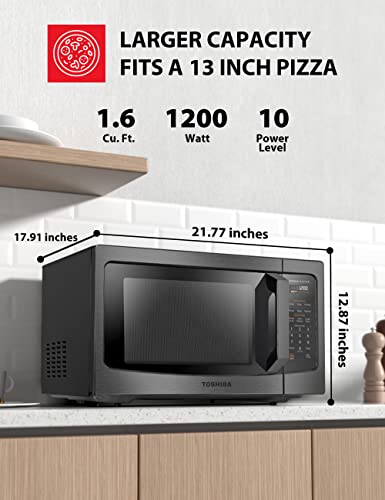The Best Countertop Inverter Microwave, Expert Recommendations
Meet the ultimate inverter microwave countertop model. Thanks to its next-gen inverter technology, it guarantees constant, equal cooking every time. Food overcooked on the sides, rare in the center? Not anymore! With this tech, the temperature works flawlessly, cooking dishes thoroughly from edge to edge. Despite its small size, it doesn't compromise on performance, perfect for your kitchen counter. Its easy-to-use controls and adjustable settings mean this microwave can fit every culinary need. Exquisite precision and convenience make this the finest countertop inverter microwave you can find.

The inverter microwave is the king of countertop cooking. It offers fine control of heating levels and regular cooking results. The best countertop inverter microwaves change how we prepare meals in small kitchen spaces. There's a wide variety of options to choose from, so pick careful! Look at the features, dependability, and intuitive design. We'll delve into the best ones that blend pioneering inverter tech with countertop flexibility, enabling you to reach cooking perfection easily.
10 best countertop inverter microwave
TOSHIBA ML-EM45PIT(BS) Countertop Microwave Oven with Inverter Technology, Kitchen Essentials,
View on Amazon- KR Score9.9
Kitchensradar.com established a ranking system called KR Score. KR Score is unaffected or unrelated to any websites run by manufacturers or sales agents. Learn more
- BrandTOSHIBA
- KR Score9.8
Kitchensradar.com established a ranking system called KR Score. KR Score is unaffected or unrelated to any websites run by manufacturers or sales agents. Learn more
- BrandLG
Panasonic Microwave Oven NN-SN686S Stainless Steel Countertop/Built-In with Inverter Technology
View on Amazon- KR Score9.7
Kitchensradar.com established a ranking system called KR Score. KR Score is unaffected or unrelated to any websites run by manufacturers or sales agents. Learn more
- BrandPanasonic
TOSHIBA ML-EM45PIT(SS) Countertop Microwave Oven with Inverter Technology, Kitchen Essentials,
View on Amazon- KR Score9.6
Kitchensradar.com established a ranking system called KR Score. KR Score is unaffected or unrelated to any websites run by manufacturers or sales agents. Learn more
- BrandTOSHIBA
- KR Score9.5
Kitchensradar.com established a ranking system called KR Score. KR Score is unaffected or unrelated to any websites run by manufacturers or sales agents. Learn more
- BrandPanasonic
- KR Score9.4
Kitchensradar.com established a ranking system called KR Score. KR Score is unaffected or unrelated to any websites run by manufacturers or sales agents. Learn more
- BrandTOSHIBA
- KR Score9.2
Kitchensradar.com established a ranking system called KR Score. KR Score is unaffected or unrelated to any websites run by manufacturers or sales agents. Learn more
- BrandGE
- KR Score9.1
Kitchensradar.com established a ranking system called KR Score. KR Score is unaffected or unrelated to any websites run by manufacturers or sales agents. Learn more
- BrandPanasonic
- KR Score8.8
Kitchensradar.com established a ranking system called KR Score. KR Score is unaffected or unrelated to any websites run by manufacturers or sales agents. Learn more
- BrandToshiba
- KR Score8.5
Kitchensradar.com established a ranking system called KR Score. KR Score is unaffected or unrelated to any websites run by manufacturers or sales agents. Learn more
- BrandPanasonic
Last update on 2024-08-20 / Affiliate links / Images, Product Titles, and Product Highlights from Amazon Product Advertising API
Choosing a countertop inverter microwave involves understanding the benefits of inverter technology and considering various features to ensure the appliance meets your cooking needs. Inverter microwaves offer precise power control and consistent cooking results. Here's a comprehensive guide to help you choose the best countertop inverter microwave:
1. Size and Capacity
Kitchen Space: Measure the available space on your countertop to ensure the microwave fits comfortably. Consider both the footprint and the height of the appliance.
Internal Capacity: Countertop microwaves range in capacity from 0.5 to 2.2 cubic feet. For most households, 1.0 to 1.5 cubic feet is sufficient. Larger capacities are better for families or if you frequently cook large dishes.
2. Power and Performance
Wattage: Inverter microwaves typically range from 800 to 1200 watts. Higher wattage allows for faster cooking times and more efficient heating. For most cooking tasks, a microwave with 1000 to 1200 watts is ideal.
Inverter Technology: This technology allows for continuous and precise power control, providing more even cooking and better results for delicate foods. It prevents overcooking and helps retain food's texture and flavor.
3. Cooking Functions and Features
Preset Programs: Look for models with preset cooking functions for common tasks such as popcorn, pizza, vegetables, and beverages. These presets simplify cooking and ensure consistent results.
Sensor Cooking: Sensor cooking technology adjusts cooking time and power automatically based on the food’s moisture and temperature, ensuring perfect results every time.
Defrost Function: An inverter microwave’s defrost function is more accurate and prevents partial cooking during defrosting, preserving the quality of your food.
Keep Warm Function: Some models offer a keep warm function that maintains food at a low, consistent temperature until you're ready to serve.
4. Ease of Use and Cleaning
Control Panel: Choose a microwave with an intuitive control panel. Digital displays and touchpad controls are generally easier to use and more precise than analog dials.
Turntable vs. Flatbed: Turntables help ensure even cooking, while flatbed designs offer more usable space and are easier to clean.
Interior Material: Stainless steel or ceramic interiors are easier to clean and maintain compared to plastic. Look for removable trays and racks for easier cleaning.
5. Build Quality and Design
Materials: Stainless steel models are durable and easier to clean, offering a sleek, modern look. Ensure the build quality is robust to withstand regular use.
Aesthetics: Select a design that complements your kitchen décor. Inverter microwaves come in various styles and finishes to match different tastes.
6. Brand and Reviews
Reputation: Opt for reputable brands known for quality and reliability, such as Panasonic, Sharp, LG, and Toshiba.
Customer Reviews: Reading customer reviews can provide insights into real-world performance and potential issues. Look for feedback on durability, ease of use, and customer service.
7. Price and Warranty
Budget: Countertop inverter microwaves range from $100 to $300, depending on the features and quality. Determine your budget based on the features you need.
Warranty: A good warranty provides peace of mind. Look for models with at least a one-year warranty, and check if the brand offers extended warranties.
8. Additional Features
Child Lock: A child lock feature is essential for safety if you have young children at home.
Quick Start: A quick start feature allows you to start the microwave quickly at full power, which is convenient for simple tasks.
Energy Efficiency: Consider energy-efficient models to save on electricity bills and reduce your environmental footprint.
9. Installation and Maintenance
Countertop Placement: Ensure the microwave is placed on a stable, flat surface with adequate ventilation around it to prevent overheating.
Maintenance: Consider the ease of maintaining the microwave. Models with self-cleaning features or easy-to-clean interiors can save you time and effort.
By considering these factors, you can choose a countertop inverter microwave that fits your kitchen space, meets your cooking needs, and offers the best value for your investment. An inverter microwave can enhance your cooking experience with precise power control and efficient performance, making it a valuable addition to any kitchen.
The "top" inverter microwave is relative to your own needs and what you prefer. Things like your budget and important features also count. But, Panasonic is a recognized brand for making respected inverter microwaves. People like the Panasonic models NN-SN966S and NN-SN686S for their consistency, functionality, and advanced inverter technology.
Do you need an inverter microwave?
Many believe inverter microwaves are worth it. The reason? They heat efficiently and evenly. This accurate control of cooking power can enhance meal quality. Plus, these appliances save energy. So, over time, you can also reduce electricity use and save time.
What about a convection oven vs. an inverter microwave?
There's no clear winner here. It really depends on what you're cooking. An inverter microwave is great for everyday heating tasks, thanks to its fast and precise temperature control. On the other hand, convection ovens distribute heat with a fan. This provides even cooking and browning—perfect for baking, roasting, and crisping food. So, your cooking style will determine the best choice for you.
How about Panasonic inverter microwaves?
Generally, people have a high opinion of Panasonic inverter microwaves. Why? This technology offers even, consistent heating for better cooking outcomes. Panasonic is trusted for making durable appliances. Plus, many users give these inverter microwaves favorable reviews for their strong performance and user-friendly features.
Is it safe to place metal in an inverter microwave?
Inverter microwaves might be a bit safer than regular ones with metal inside, but it's still a no-go. Why? Metal could spark or create "arcing" - sparks. Both could harm your microwave. Worse, they could start a fire. The manufacturers know best. Their guidance is clear: “Metal things, like cutlery, containers, or foil, stay out of the microwave.”
Read More:
10 Best Copper Microwave Reviewed
The 10 Best Convection Microwave Wall Oven Reviewed
The Best Over Range Microwave Exhaust Fan, Powerful & Silent
The Best Countertop Microwave With Inverter Technology Of 2024
Best Digital Microwave For Every Budget




























